
- This event has passed.
Real Time and Sparse Reconstructed Radar Imaging Through Stratified Media
December 12, 2023 @ 5:15 pm - 6:15 pm
The problem of imaging of objects within or through multilayered dielectric media appears in many areas, including those in ground-penetrating radar (GPR) imaging, through-the-wall radar imaging (TWRI), intra-wall and subsurface imaging, and medical imaging. These general areas cover many important defense and civilian applications such as those in counterterrorism and law enforcement operations, firefighting, earthquake rescue missions, detection of buried subsurface objects and minerals in GPR, millimeter wave imaging of concealed weapons and contraband carried by personnel, to name a few. In many situations, however, the dielectric media induce shadowing effects on targets, resulting in image degradation and errors in geo-locating or, possibly, complete masking of targets. Furthermore, in most practical situations the imaging of targets should be done in real-time, requiring the development of fast data acquisition schemes as well as highly efficient microwave imaging techniques that can fully account for wave propagation through various dielectric layers or walls. In this lecture, a comprehensive overview of various image reconstruction techniques for objects in stratified media will be given for both SAR-based and multiple-input multiple-output (MIMO) based systems, and for both real-time imaging and sparsity-based imaging scenarios. For the former, we will describe the use of efficient 2D and 3D Diffraction Tomography (DT) techniques which use first order Born approximation together with successive implementations of spatial fast-Fourier transform (FFT) and inverse-FFT (IFFT), to arrive at high-resolution images. Such fast-imaging techniques, however, do not address the problem posed by long data acquisition time associated with most microwave-imaging scenarios. To address this problem, assuming a sparse target space, one can resort to the use of Compressive Sensing (CS) to significantly reduce the number of antennas and/or collected frequency points. In our implementation of CS, the wall or multilayered media effects are accurately and efficiently accounted for in the sparse-image reconstruction through the use of approximate expressions for the Green’s functions of multi-layered lossy dielectric medium. In particular, the use of total variation minimization (TVM) and its advantages over the l1-norm minimization, which is often used in the standard radar implementation of CS, will be detailed. Numerical and experimental results for DT-based and CS-based radar imaging in various GPR and TWRI scenarios will be given in the presentation. Speaker(s): Prof. Ahmad Hoorfar, Bldg: Pavillon Principal, B 600.16, la Galerie Rolland, 2500 Chem. de Polytechnique, Montréal, Quebec, Canada, H3T 1J4

